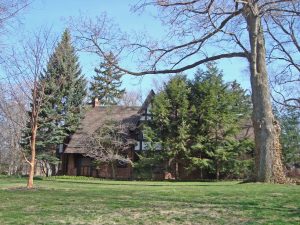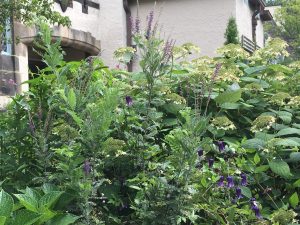 When reading a newspaper or articles online or watching social media, much of the thrust is about the future, mostly focused on climate change and its effects on the environment. Those of us who garden know how important this is and we are learning to adapt to these changes.
When reading a newspaper or articles online or watching social media, much of the thrust is about the future, mostly focused on climate change and its effects on the environment. Those of us who garden know how important this is and we are learning to adapt to these changes.

The trees on this property are planted to close to the house that they let in little light and are probably damaging the façade and roof of the house.

These Forsythia have been planted brutally pruned because they are too close to the driveway.
However, I invite you to approach the future with my landscape designer’s lens. All too often, what I see is trees and shrubs that were sited without regard to their mature size. How many times have you seen trees planted so close to the house that they eventually hide the house or the branches scrape the house and the roof? I don’t have enough fingers to count the number of times that Forsythia and Burning Bush are planted as a hedge along a driveway. Both plants want to be huge and look unbelievably ugly when pruned. Instead of barbaric pruning, the solution should be bifold: removal and then replacement with an appropriate plant. Try to think ahead. Ultimately, plants that are installed in the wrong place will have to be removed, an unnecessary expenditure for you and a loss to the environment, particularly trees that take so long to reach maturity.

During a snowy winter, robins flocked to the crabapple outside my office window.
The combination of global warming and insect infestations is decimating our forests, urban canopies, and tree lawns. Sadly, we are not replacing trees equally with the number being removed. If every property would plant at least one tree, that would help counter this trend. Not all spaces are large enough to encompass an oak but this genus is the most important one for hosting the caterpillars of beneficial insects and butterflies. I love crabapples and there is a multiplicity from which to choose. They are not natives but, during many winters, I have watched robins feast on the fruits.

As this photo demonstrates, screening does not need to be a monoculture: Veronicastrum ‘Fascination’, Clematis ‘Rooguchi’, Hydrangea arborescens ssp. radiata, foliage of Amorpha fruticosa
Many shrubs have been hybridized or have different species and cultivars. The multitude of offerings can be confusing so research is crucial. The range of heights, colors, aggressiveness, and the ability to bloom in sun or part shade should all be considered in siting. If you want screening, dwarf cultivars of Hydrangea arborescens like ‘Wee White’ or ‘Mini Mauvette’ will not be appropriate. However, Hydrangea arborescens ssp.radiata will grow at least six feet tall and wide; it becomes quite woody so needs little maintenance. An asset of a deciduous shrub as a screener is the ability to withstand heavy snow load unlike many conifers that often end up bent or disfigured. Global warming means that while we may have milder winters overall, we will still encounter weather extremes like heavy snowfalls.

This “beehive” of activity on Pycnanthemum muticum includes wasps and other pollinators as well.
During the pandemic, many more people have started to garden. The same issues that I am raising with selection and siting of trees and shrubs also pertain to perennials and ornamental grasses. In the past few years, I have become a devotee of Pycnanthemum muticum (Mountain Mint). When I purchased it, I was aware of its aggressive nature but, unlike many other rhizomatous perennials, I can easily pull unwanted stems. Why am a fan of this particular perennial? Because it is a pollinator heaven. I see more bees, wasps, and butterflies on this plant than any other in my garden. I also happen to love the silver foliage and bracts.
I mentioned insect infestations above but I need to tell you about a lecture that I accessed through the Perennial Plant Assocation virtual conference this week. One of the speakers was Joe Boggs, an assistant professor of entomology at The Ohio State University. Entitled “Connect the Dots”: Plant Diversity, Pollinators, and Pest Management”, his talk validated my belief that if you have a diverse garden, it will be full of pollinators even as the media is decrying the loss of pollinators. As Joe said: “ Flower power equals natural enemies.”
Not everyone has the space or the interest for over a thousand genera, species, and cultivars of plants (yes, I’m a plant-a-holic) but monoculture is a disaster for insects. We want to invite those who are predators into our gardens and landscapes. How? By supplying them with as many sources of nectar as possible. What are those sources? Flowers and lots of them. It’s not just perennials and shrubs that have flowers; many trees, such as Cercis (Redbud), Catalpa, Aesculus (Horsechestnut or Buckeye), and Amelanchier (Serviceberry) flower in the spring when the insects get the energy they need from the nectar of these flowers. Those who use herbicides and pesticides are destroying the good guys as well as the bad ones. Doesn’t it make more sense to use the good guys for pest management? Yes, it will mean that some leaves are not perfect but that is a small price to pay. Think of pollinator gardens, so trendy, as pest management gardens.
So, enough preaching. Just remember that we can create beautiful, diverse landscapes that will help the environment and be there for our children and grandchildren to enjoy.


0 Comments